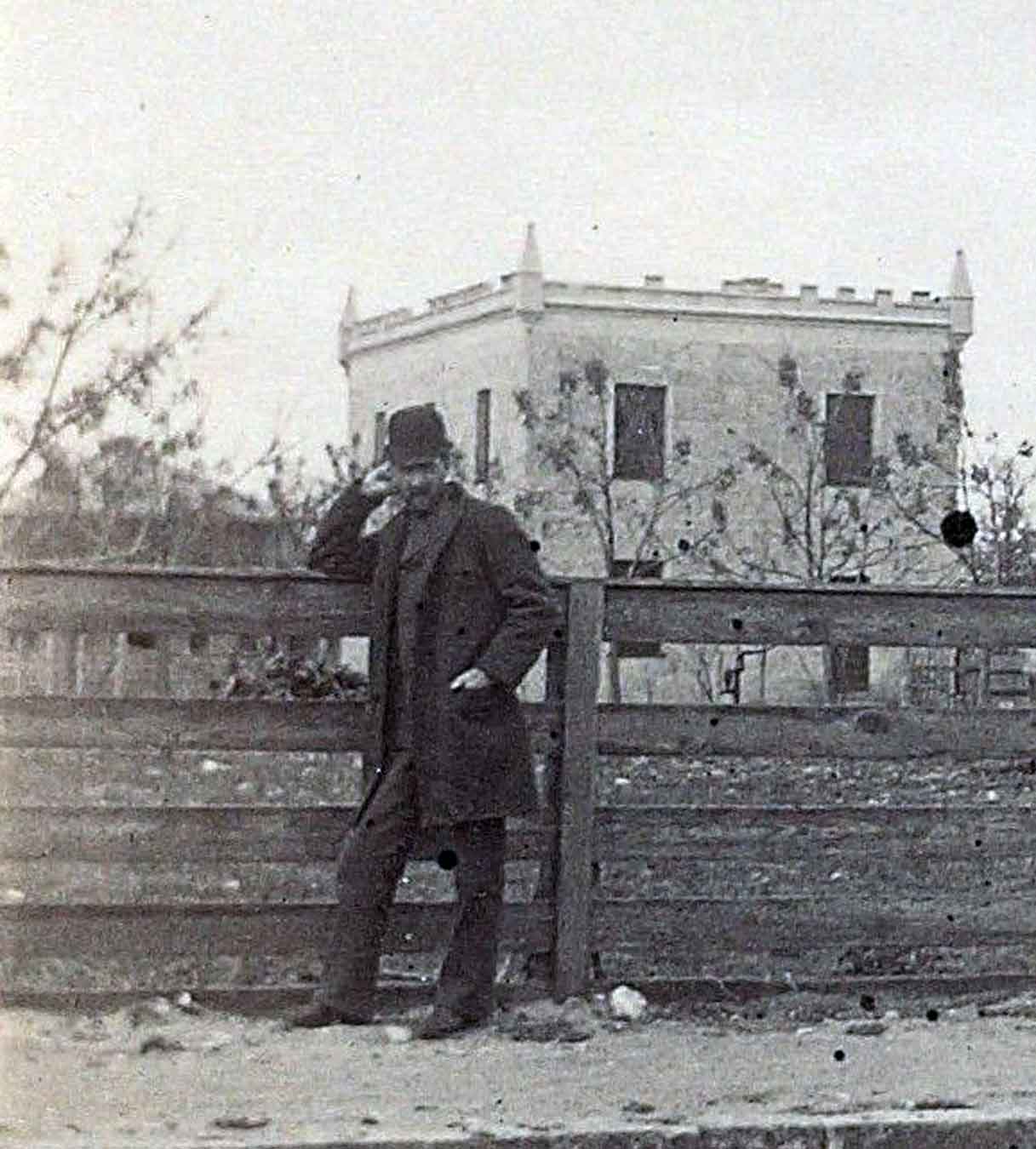 |
| A carriage in front of the 2nd Kerr County Courthouse, where Monsieur Charles Compte de Keroman was tried -- twice. Click on any image to enlarge. |
In October, 1879, a burglar quietly opened the safe of the Center Point firm of Faltin, Schreiner, and Below. Though the safe contained around $1,200, only a little over $300 was taken. Suspicion soon fell upon a man who had visited the store the day before the money went missing – and was later found to have a little over $200 in cash hidden in his hat.
That suspect also happened to be a French count, Monsieur Charles Compte de Keroman – or, more plainly, Count Keroman. He was arrested in Comfort, and indicted in Kerrville.
The case against the count was purely circumstantial. Two $50 bills were taken from the safe in Center Point, and two $50 bills, along with other currency, were found in Count Keroman’s hat. The missing $50 bills were not recorded, nor were their serial numbers known.
According to a report in the November 22, 1879 issue of the Galveston Daily News, when the count could not provide a $2,000 bond, he was to be jailed in Kerrville, “but escaped this unpleasantness of jail associations by paying eight dollars a day to three men who guarded him until his friends in San Antonio could come to his rescue with the requisite security.”
 |
| A tourist posing in front of the same courthouse |
The story suggests the case against Keroman was actually a grudge against the Ganahl family, of Center Point, with whom the count had been living. “Count Keroman’s troubles grew out of the simple fact that he lived with a family against whom a ring of Kerr County officials has a spite. Dr. Ganahl…is the object of bitter hostility on the part of the crowd who are most prominent in annoying Count Keroman. It is openly boasted in Kerr County that these parties will run Dr. Ganahl out of the county.”
Meanwhile, newspapers across the state were reporting on the trial, and some of the reporting strayed into opinion and speculation, including an article signed ‘Kleptomania,’ which was published on November 7, 1879. That particular article drew a response from the count.
According to the count, the writer of the article, ‘Kleptomania,’ “is beneath the notice of a gentleman; but since his villainous attack on my character has been given to the public…I am constrained to take notice of it….” The count addressed the writer directly: “Though he had not the courage to write an article over his own proper name (if he has any), I will yet descend to his level to inform him that he has published that article at a time he knew I could not defend myself, being in custody, and therefore has stamped himself a coward.” Those sound like fighting words to me.
His first trial was held in March, 1880. His attorneys asked for a continuance, on the grounds that several material witnesses, including Mrs. Victoria Ganahl, John Withers, of San Antonio, and P. Barrelli, the French consul at Galveston, were absent from Kerrville for the trial. This continuance was granted, and the trial was delayed until the next session of the court, in September, 1880.
His lawyers also asked for a change of venue, which was denied.
In September, his trial ended in a mistrial, when the jurors could not agree on a verdict. Five voted to convict; seven to acquit. Another trial was called for, and a change of venue was finally granted, moving the trial to Medina County.
This move to Medina County is interesting to me. It was arranged by a lawyer for Keroman, a Mr. Gosling, who was also the editor and publisher of the Castroville Quill. The trail was to be held in Castroville – a town settled, for the most part, by Alsatians. This time, the jurors deciding the case would be French-born Texans, and unfamiliar with the intrigues of Kerr County politics.
When the case finally came to trial, in April, 1882, the district attorney “stated that he had become acquainted with facts that proved the count’s innocence, and the judge dismissed the case.”
The count had been busy since his arrest in Kerr County in 1879; in February 1882, he was charged with an assault with an intent to murder the family (and staff) of a Dr. Cupples in San Antonio. That charge was also dropped, evidently.
In June, 1882, Count Keroman married Julia Barrette, the daughter of a San Antonio restauranteur, who operated a French café on Main Street. The marriage took place in Orange, Texas, with no notice, as it had been “kept quiet.”
The couple’s happiness was short-lived. The count died of yellow fever in Panama, in November, 1883, while engaged at work on the De Lesseps Canal. His wife was at his side when he died.
The brief obituary, in the November 30, 1883, issue of the Galveston Daily News, ends with this: “Deceased was a wild and adventurous character, and made some narrow escapes from the clutches of the law.”
I’m not so sure Keroman was completely innocent of the burglary of Charles Schreiner’s store in Center Point, and we will never know the complete story.
Until next week, all the best.
Joe Herring Jr. is a Kerrville native who enjoys studying Kerr County stories. This column originally appeared in the Kerrville Daily Times October 29, 2022.
You can help by sharing this story with someone, by forwarding it by email, or sharing it on Facebook. Sharing is certainly caring. (It's almost gift-giving season. I have two books filled with historic photographs that make fine presents. Click here for more information.)


No comments:
Post a Comment
Please remember this is a rated "family" blog. Anything worse than a "PG" rated comment will not be posted. Grandmas and their grandkids read this, so please, be considerate.